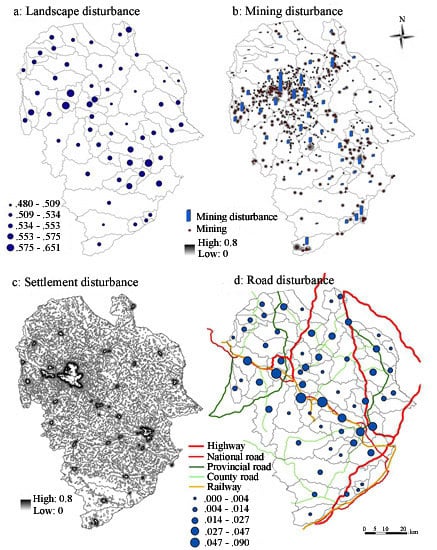Assessing Landscape Ecological Risk in a Mining City: A Case Study in Liaoyuan City, China
Abstract
:1. Introduction
2. Materials and Methods
2.1. Study Area and Data Source
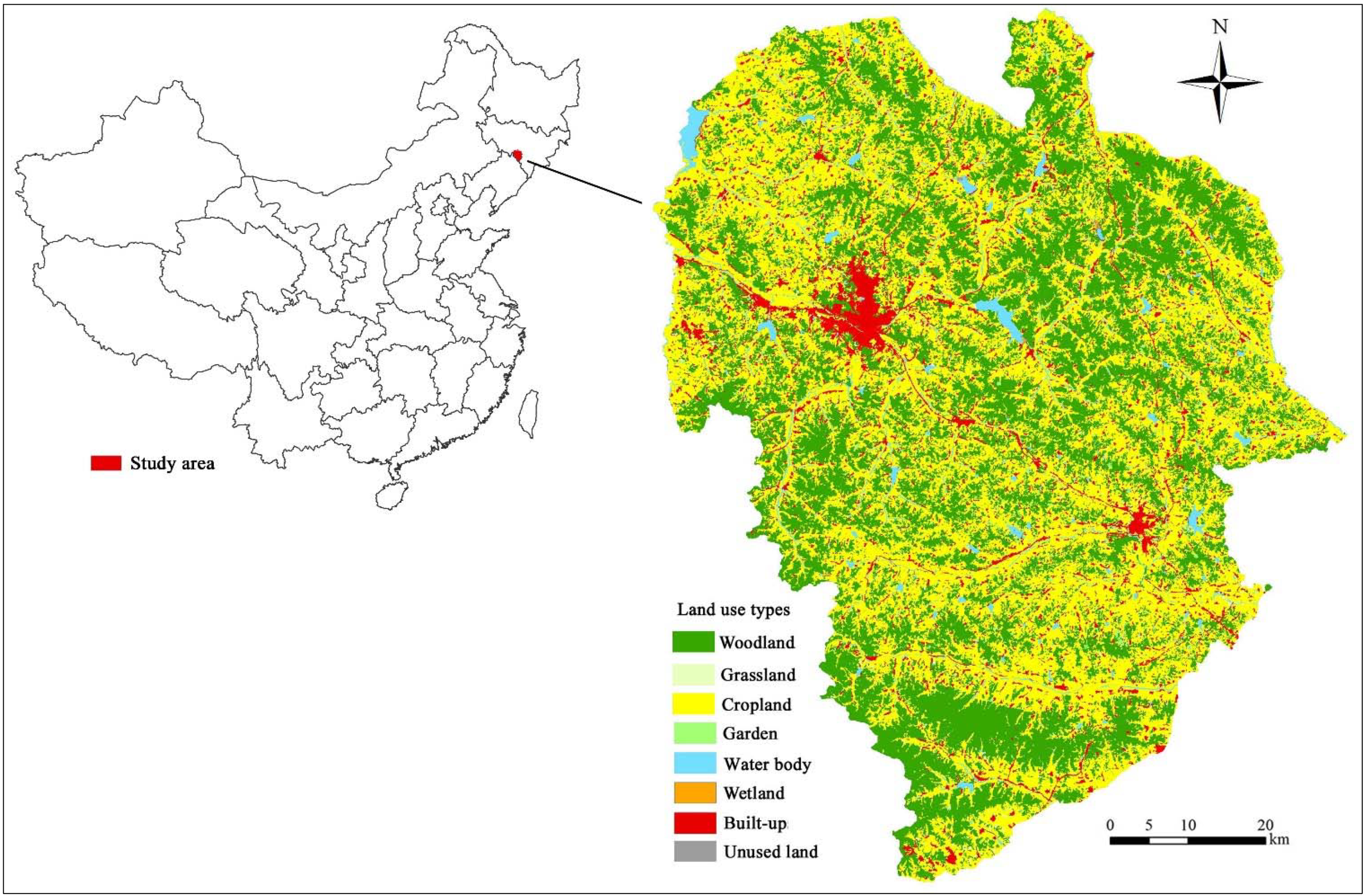

2.2. Calculation of Landscape Ecological Risk
2.2.1. Ecological Disturbance
| Disturbance | Mining | Settlement | Road | |||||||
|---|---|---|---|---|---|---|---|---|---|---|
| Level | Large mining (>10 ha) | Medium mining (1–10 ha) | Small mining (<1 ha) | City | Designated Town | Rural settlement | National road | Provincial road | County road | Highways & railways |
| Number of Buffer | 4 | 3 | 2 | 2 | 2 | 2 | 3 | 3 | 2 | 2 |
| Distance/meter (influence value) | 300(0.8) 600(0.6) 1000(0.4) 2000(0.2) | 300(0.6) 600(0.4) 1000(0.2) | 300(0.4) 600(0.2) | 600(0.8) 1200(0.4) | 400(0.6) 1000(0.3) | 200(0.4) 500(0.1) | 50(0.8) 250(0.5) 500(0.1) | 50(0.7) 100(0.5) 500(0.1) | 50(0.6) 100(0.1) | 30(0.5) 50(0.1) |
2.2.2. Ecological Vulnerability
| Woodland | Grassland | Cropland | Garden | Water Body | Wetland | Unused Land | ||
|---|---|---|---|---|---|---|---|---|
| Ecological sensitivity | Landscape fragmentation | 0.9001 | 0.7286 | 0.9821 | 0.4864 | 0.9518 | 0.8936 | 0.4563 |
| Area ratio (slope > 15°) | 0.0999 | 0.2714 | 0.0179 | 0.5136 | 0.0482 | 0.1064 | 0.5437 | |
| Ecological resilience | Landscape connectivity | 0.9359 | 0.2309 | 0.9768 | 0.3165 | 0.2951 | 0.2897 | 0.2500 |
| Landscape dominancy | 0.0641 | 0.7691 | 0.0232 | 0.6835 | 0.7049 | 0.7103 | 0.7500 |
2.2.3. Ecological Importance
2.3. Monte Carlo Analysis of Assessment Uncertainty
| Land USE degree | Possible Land Use Degree | |||
|---|---|---|---|---|
| Level-1 (0.2) | Level-2 (0.4) | Level-3 (0.6) | Level-4 (0.8) | |
| Level-1 (0.2) | 0.8/0.6 | 0.2/0.4 | 0/0 | 0/0 |
| Level-2 (0.4) | 0.1/0.2 | 0.8/0.6 | 0.1/0.2 | 0/0 |
| Level-3 (0.6) | 0/0 | 0.1/0.2 | 0.8/0.6 | 0.1/0.2 |
| Level-4 (0.8) | 0/0 | 0/0 | 0.2/0.4 | 0.8/0.6 |
| Vulnerability of Landscape Types | Possible Vulnerability of Landscape Types | ||||||
|---|---|---|---|---|---|---|---|
| Level-1 (0.0357) | Level-2 (0.0714) | Level-3 (0.1429) | Level-4 (0.1071) | Level-5 (0.1786) | Level-6 (0.2143) | Level-7 (0.2500) | |
| Level-1 (0.0357) | 0.8/0.6 | 0.2/0.4 | 0/0 | 0/0 | 0/0 | 0/0 | 0/0 |
| Level-2 (0.0714) | 0.1/0.2 | 0.8/0.6 | 0.1/0.2 | 0/0 | 0/0 | 0/0 | 0/0 |
| Level-3 (0.1429) | 0/0 | 0.1/0.2 | 0.8/0.6 | 0.1/0.2 | 0/0 | 0/0 | 0/0 |
| Level-4 (0.1071) | 0/0 | 0/0 | 0.1/0.2 | 0.8/0.6 | 0.1/0.2 | 0/0 | 0/0 |
| Level-5 (0.1786) | 0/0 | 0/0 | 0/0 | 0.1/0.2 | 0.8/0.6 | 0.1/0.2 | 0/0 |
| Level-6 (0.2143) | 0/0 | 0/0 | 0/0 | 0/0 | 0.1/0.2 | 0.8/0.6 | 0.1/0.2 |
| Level-7 (0.2500) | 0/0 | 0/0 | 0/0 | 0/0 | 0/0 | 0.2/0.4 | 0.8/0.6 |
3. Results
3.1. Probability of Landscape Ecological Risk
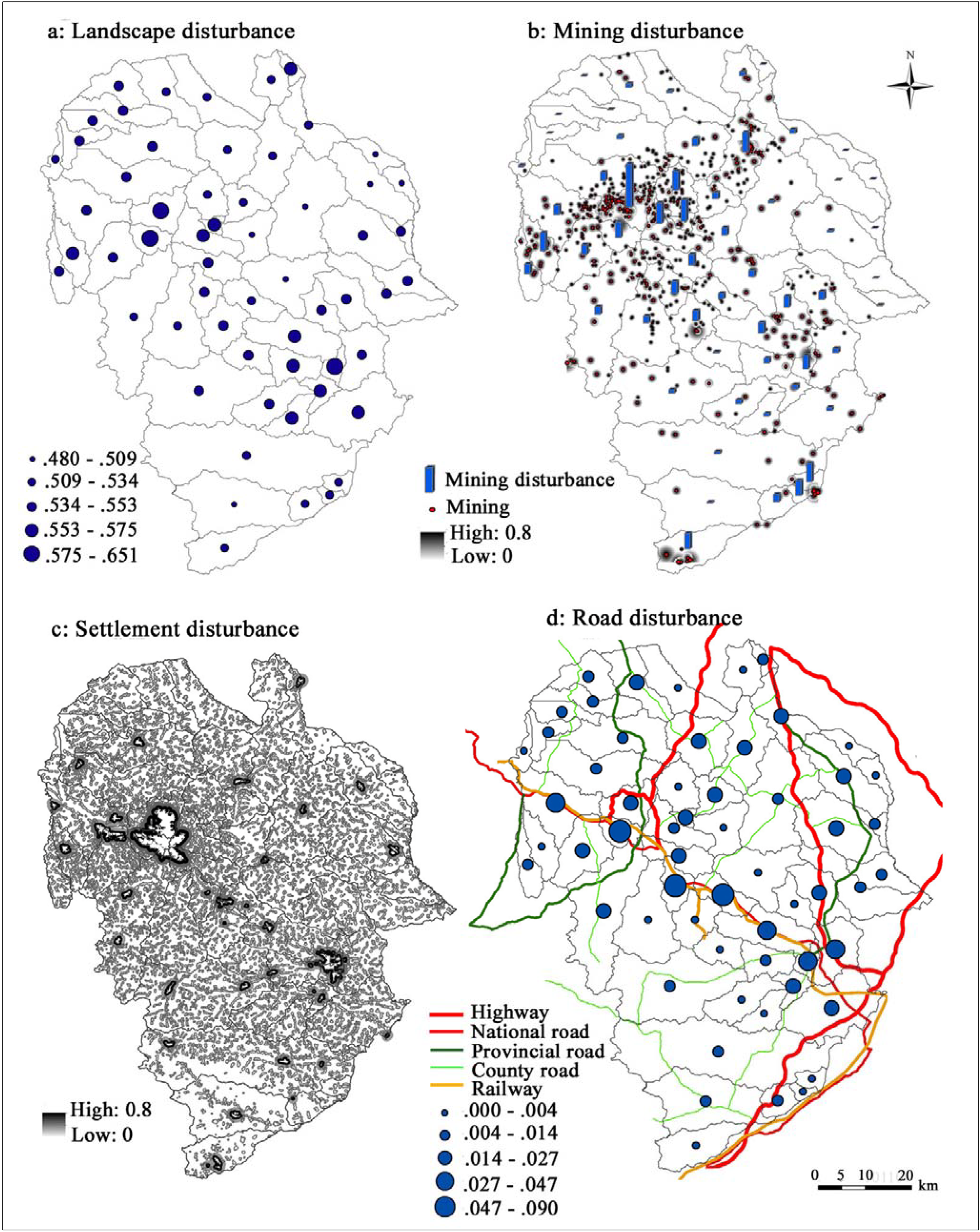
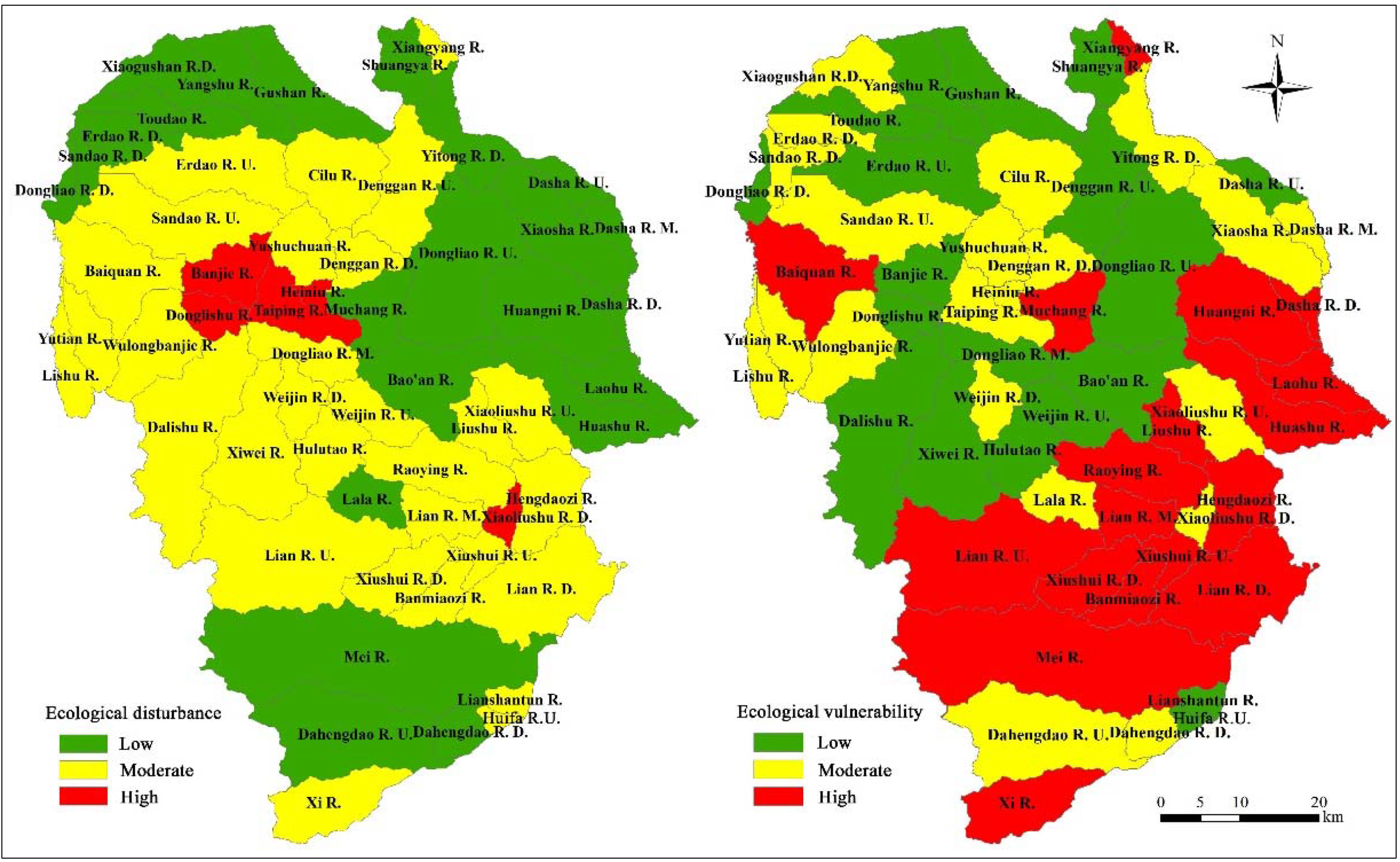

3.2. Ecological Loss and Landscape Ecological Risk
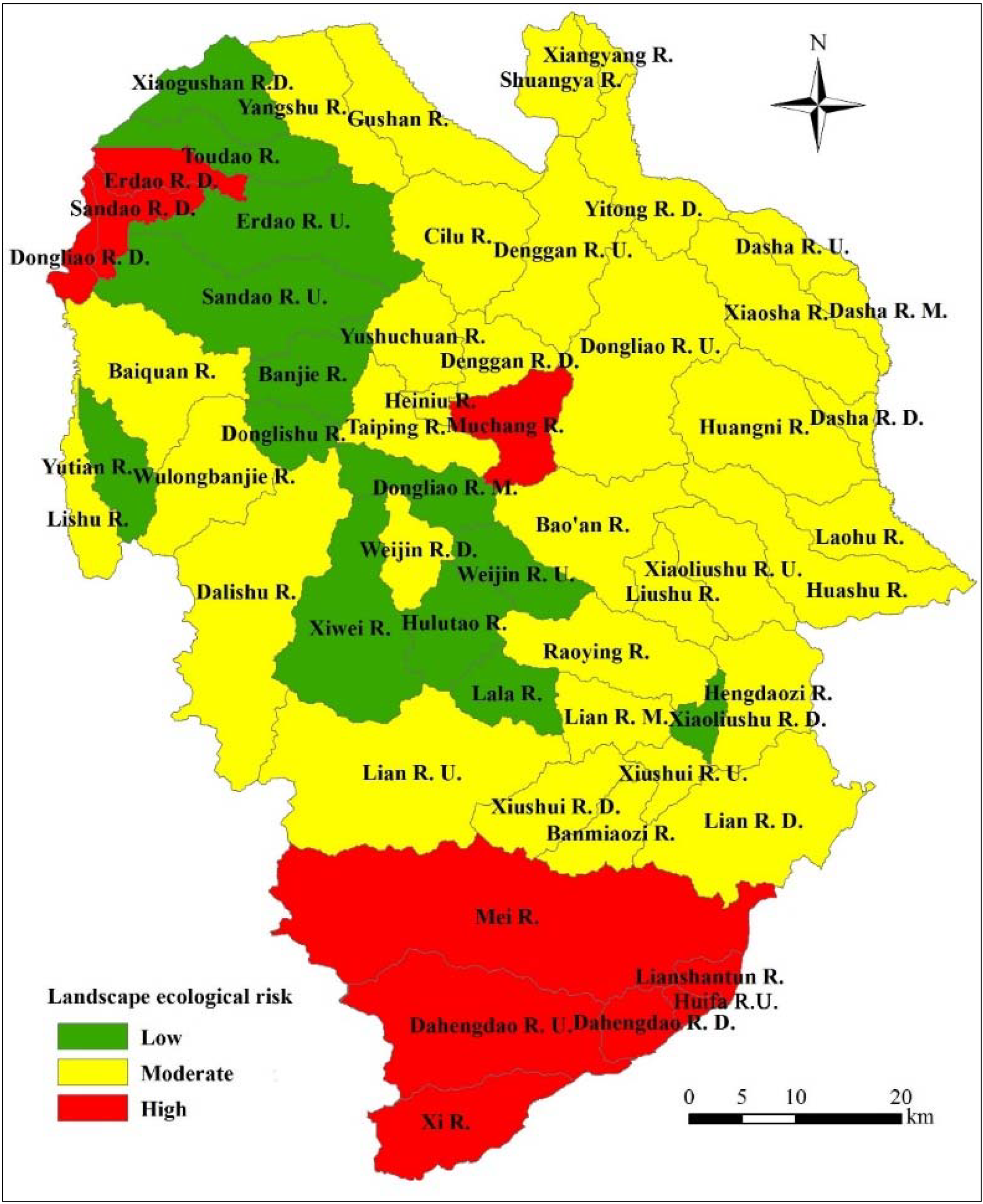
3.3. Zoning of Landscape Ecological Risk
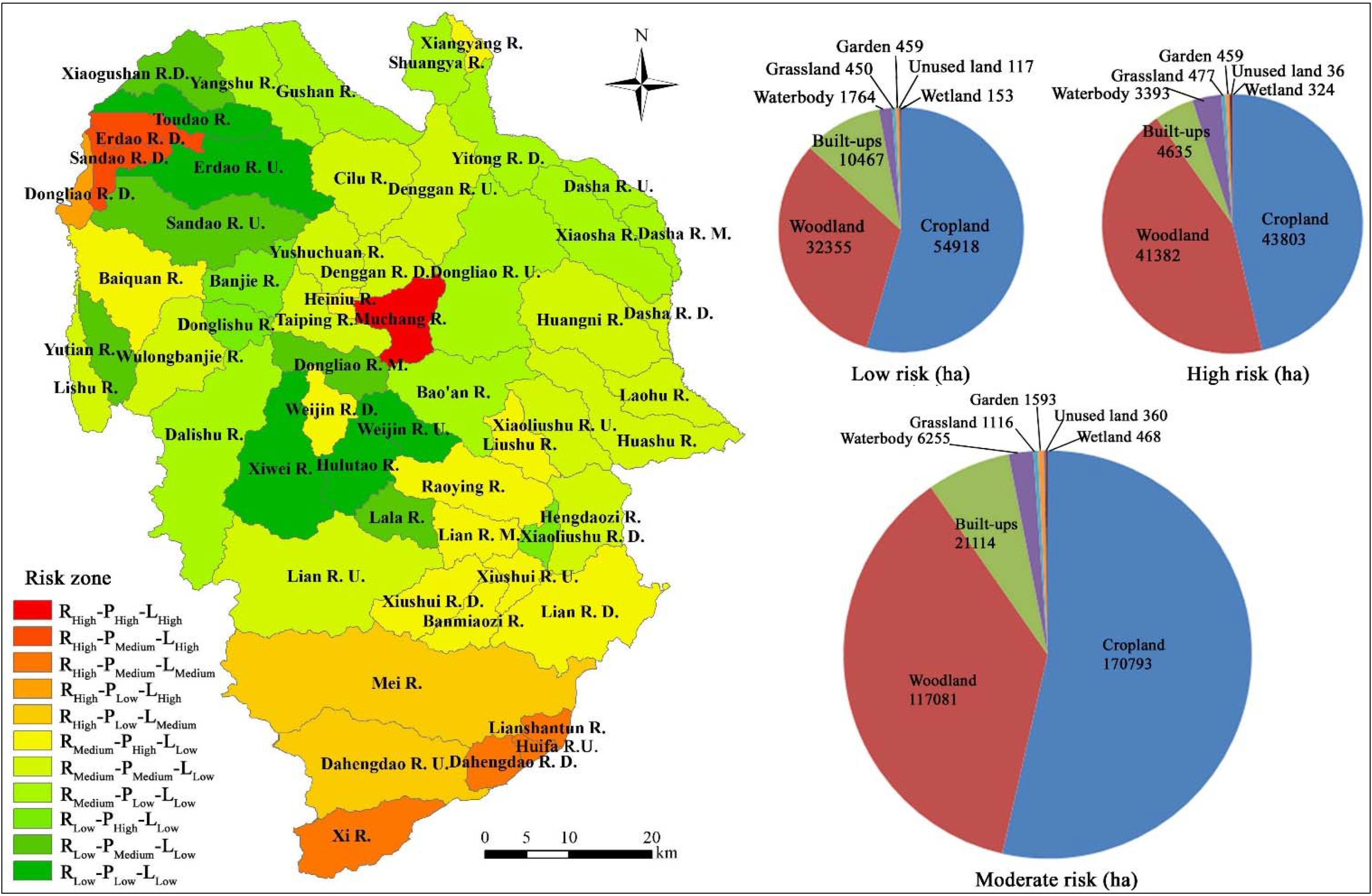
4. Discussion
4.1. Implications of Assessment Results of Landscape Ecological Risk
4.2. Uncertainty of Landscape Ecological Risk Assessment

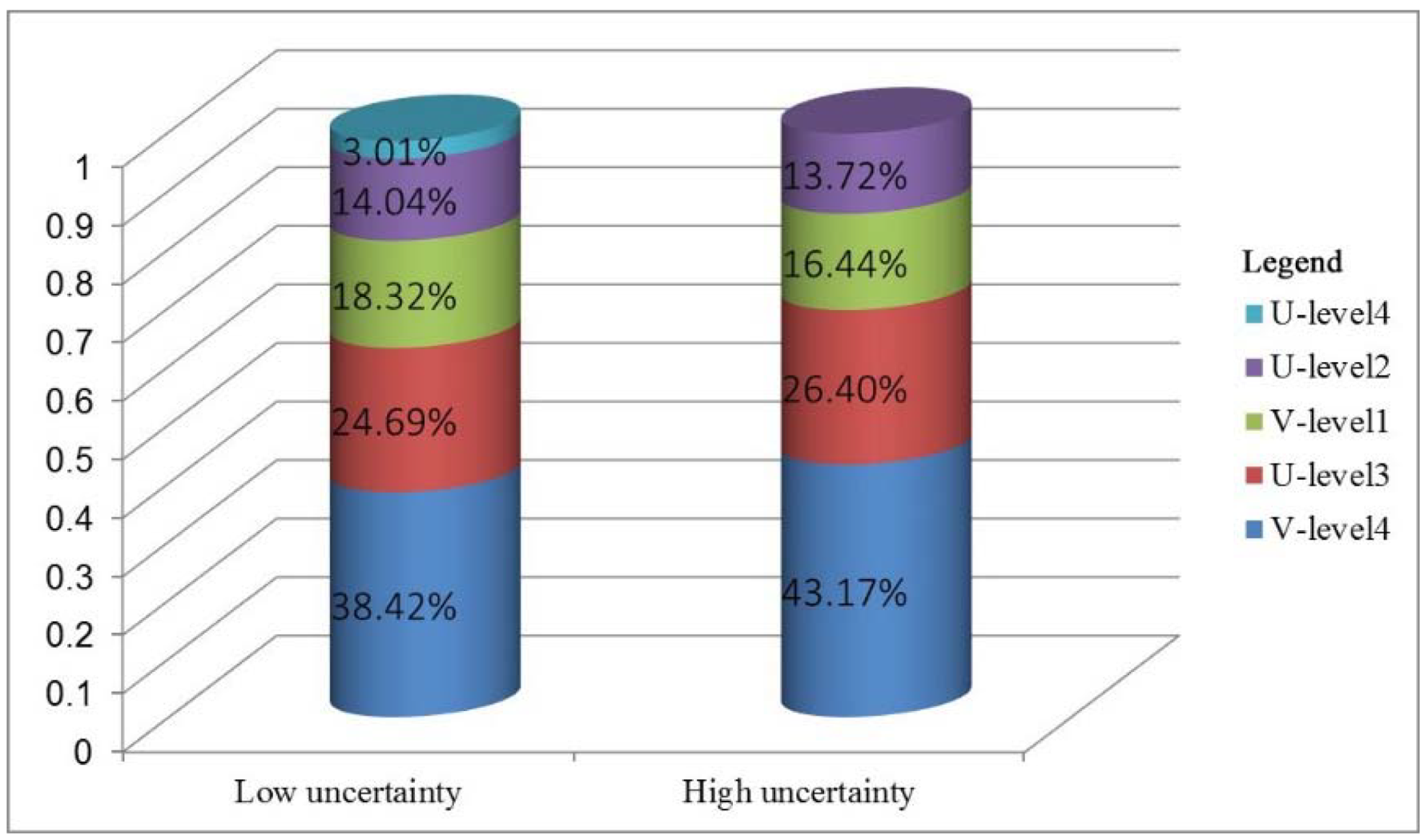
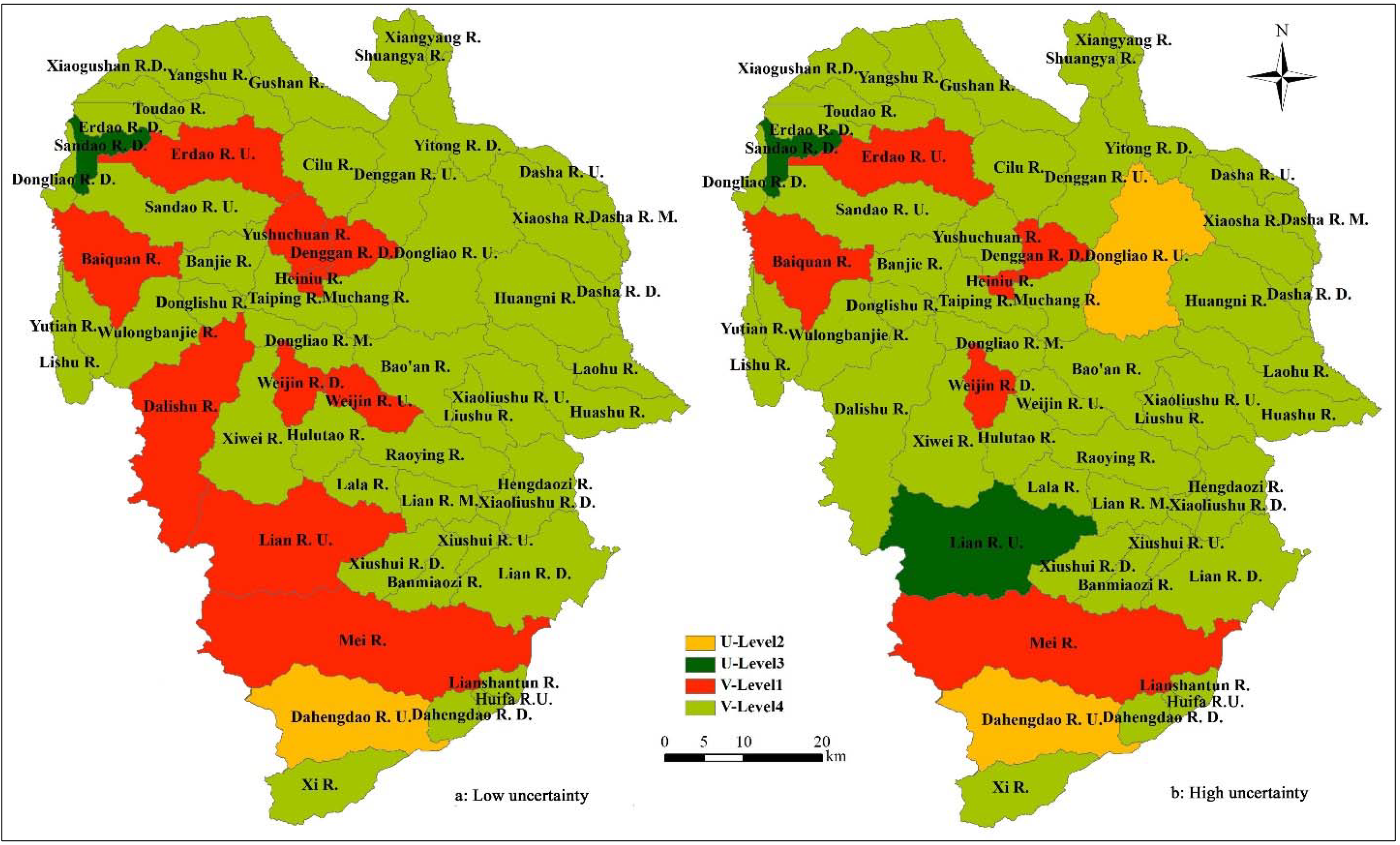
5. Conclusions
Acknowledgments
Author Contributions
Conflicts of Interest
References
- Wu, J.G. Landscape sustainability science: Ecosystem services and human well-being in changing landscapes. Landsc. Ecol. 2013, 28, 999–1023. [Google Scholar] [CrossRef]
- Peng, J.; Wu, J.S.; Pan, Y.J.; Han, Y.N. Evaluation for regional ecological sustainability based on PSR model: Conceptual framework. Prog. Geogr. 2012, 31, 933–940. (In Chinese) [Google Scholar]
- Xu, E.G.B.; Leung, K.M.Y.; Morton, B.; Lee, J.H.W. An integrated environmental risk assessment and management framework for enhancing the sustainability of marine protected areas: The Cape d’Aguilar Marine Reserve case study in Hong Kong. Sci. Total Environ. 2015, 505, 269–281. [Google Scholar] [CrossRef] [PubMed]
- Hunsaker, C.T.; Graham, R.L.; Suter, G.W.; O’Neill, B.L.; Jackson, B.L.; Barnthouse, L.W. Regional Ecological Risk Assessment: Theory and Demonstration; Oak Ridge National Lab: Oak Ridge, TN, USA, 1989. [Google Scholar]
- Hunsaker, C.; Graham, R.; Suter, G.; O’Neill, R.; Barnthouse, L.; Gardner, R. Assessing ecological risk on regional scale. Environ. Manag. 1990, 14, 325–332. [Google Scholar] [CrossRef]
- Adams, S.M.; Bevelhimer, M.S.; Greeley, M.S.; Levine, D.A.; Teh, S.J. Ecological risk assessment in a large river-reservoir: 6. Bioindicators of fish population health. Environ. Toxicol. Chem. 1999, 18, 628–640. [Google Scholar]
- Baron, L.A.; Sample, B.E.; Suter, G.W. Ecological risk assessment in a large river-reservoir: 5. Aerial insectivorous wildlife. Environ. Toxicol. Chem. 1999, 18, 621–627. [Google Scholar]
- Cook, R.B.; Suter, G.W.; Sain, E.R. Ecological risk assessment in a large river-reservoir: 1. Introduction and background. Environ. Toxicol. Chem. 1999, 18, 581–588. [Google Scholar]
- Jones, D.S.; Barnthouse, L.W.; Suter, G.W.; Efroymson, B.A.; Field, J.M.; Beauchamp, J.J. Ecological risk assessment in a large river-reservoir. 3. Benthic invertebrates. Environ. Toxicol. Chem. 1999, 18, 599–609. [Google Scholar]
- Sample, B.E.; Suter, G. Ecological risk assessment in a large river-reservoir: 4. Piscivorous wildlife. Environ. Toxicol. Chem. 1999, 18, 610–620. [Google Scholar]
- Landis, W.G. Twenty years before and hence: Ecological risk assessment at multiple scales with multiple stressors and multiple endpoints. Hum. Ecol. Risk Assess. 2003, 9, 1317–1326. [Google Scholar] [CrossRef]
- Peng, J.; Liu, Y.X.; Pan, Y.J.; Zhao, Z.Q.; Song, Z.Q.; Wang, Y.L. Study on the correlation between ecological risk due to natural disaster and landscape pattern-process: Review and prospect. Adv. Earth Sci. 2014, 29, 1186–1196. (In Chinese) [Google Scholar]
- Hemstrom, M.; Mezenich, J.; Reger, A.; Wales, B. Integrated analysis of landscape management scenarios using state and transition models in the upper Grande Ronde River Subbasin, Oregon, USA. Landsc. Urban Plan. 2007, 80, 198–211. [Google Scholar] [CrossRef]
- Lange, A.; Siebert, R.; Barkmann, T. Sustainability in land management: An analysis of stakeholder perceptions in rural northern Germany. Sustainability 2015, 7, 683–704. [Google Scholar] [CrossRef]
- Graham, R.L.; Hunsaker, C.T.; O’Neil, R.V. Ecological risk assessment at the regional scale. Ecol. Appl. 1991, 1, 196–206. [Google Scholar] [CrossRef]
- Kapustka, L.A.; Galbraith, H.; Luxon, M. Using landscape ecology to focus ecological risk assessment and guide risk management decision-making. Toxicol. Ind. Health 2001, 17, 236–246. [Google Scholar] [CrossRef] [PubMed]
- Liu, S.L.; Cui, B.S.; Dong, S.K.; Yang, Z.F.; Yang, M.; Holt, K. Evaluating the influence of road networks on landscape and regional ecological risk a case study in Lancang River Valley of Southwest China. Ecol. Eng. 2008, 34, 91–99. [Google Scholar] [CrossRef]
- Yin, H.; Wang, Y.L.; Cai, J.L.; Lv, X.F.; Liu, X.Q. Regional ecological risk assessment: Its research progress and prospect. Chin. J. Ecol. 2009, 28, 969–975. (In Chinese) [Google Scholar]
- Xie, H.L. Regional eco-risk analysis of based on landscape structure and spatial statistics. Acta Ecol. Sin. 2008, 28, 5020–5026. (In Chinese) [Google Scholar]
- Jing, Y.P.; Zhang, S.W.; Li, Y. Ecological risk analysis of rural-urban ecotone based on landscape structure. Chin. J. Ecol. 2008, 27, 229–234. (In Chinese) [Google Scholar]
- Li, J.G.; He, C.Y.; Li, X.B. Landscape ecological risk assessment of natural/semi-natural landscape in fast urbanization regions—A case study in Beijing. China. J. Nat. Resour. 2008, 23, 33–47. (In Chinese) [Google Scholar]
- Wang, C.Y.; Zhang, J.; Xi, H.M.; Fu, J. Ecological risk assessment of island exploitation based on landscape pattern. Acta Ecol. Sin. 2008, 28, 2811–2817. (In Chinese) [Google Scholar]
- Li, Y.F.; Luo, Y.C.; Liu, G.; Ouyang, Z.Y.; Zheng, H. Effects of land use change on ecosystem services: A case study in Miyun reservoir watershed. Acta Ecol. Sin. 2013, 33, 726–736. (In Chinese) [Google Scholar]
- Lanis, W.G.; Wiegers, J.K. Ten years of the relative risk model and regional scale ecological risk assessment. Hum. Ecol. Risk Assess. 2007, 13, 25–38. [Google Scholar] [CrossRef]
- Liu, L.; Liu, J.; Zhang, Z.G. Environmental justice and sustainability impact assessment: In search of solutions to ethnic conflicts caused by coal mining in Inner Mongolia, China. Sustainability 2014, 6, 8756–8774. [Google Scholar] [CrossRef]
- Himley, M. Global mining and the uneasy neoliberalization of sustainable development. Sustainability 2010, 2, 3270–3290. [Google Scholar] [CrossRef]
- McLellan, B.C.; Corder, G.D. Risk reduction through early assessment and integration of sustainability in design in the minerals industry. J. Clean. Prod. 2013, 53, 37–46. [Google Scholar] [CrossRef] [Green Version]
- Chang, Q.; Qiu, Y.; Xie, M.M.; Peng, J. Theory and method of ecological risk assessment for mining areas based on the land destruction. Acta Ecol. Sin. 2012, 32, 5164–5174. (In Chinese) [Google Scholar] [CrossRef]
- Li, Z.Y.; Zhang, N.; Tang, J.; Ji, Y.; Liu, J.L. Analysis on the landscape ecological risk of Jilin coal mining area. J. Jilin Univ. (Earth Sci. Ed.) 2011, 41, 207–214. (In Chinese) [Google Scholar]
- Li, L.X.; Wang, B.; Zhou, L.B.; Yu, X.B. Ecological landscape risk evaluation in mineral resources exploitation. Conserv. Util. Miner. Resour. 2011, 2, 1–5. (In Chinese) [Google Scholar]
- Wu, J.S.; Zong, M.L.; Peng, J. Assessment of mining area’s ecological vulnerability based on landscape pattern: A case study of Liaoyuan, Jilin Province of Northeast China. Chin. J. Ecol. 2012, 31, 3213–3220. (In Chinese) [Google Scholar]
- Wang, E.H. Liaoyuan Statistical Yearbook (2009); Liaoyuan Bureau of Statistics: Liaoyuan, China, 2010. (In Chinese) [Google Scholar]
- Chang, Y.J. Liaoyuan Yearbook (2010); Jilin People's Publishing House: Liaoyuan, China, 2010. (In Chinese) [Google Scholar]
- Chen, Q.Y.; Liu, J.L. Development process and perspective on ecological risk assessment. Acta Ecol. Sin. 2014, 34, 239–245. (In Chinese) [Google Scholar] [CrossRef]
- Pickett, S.T.A.; White, P.S. Chapter 21—Patch Dynamics: A Synthesis. In The Ecology of Natural Disturbance and Patch Dynamics; White, S.T.A., Pickettp, S., Eds.; Academic Press: San Diego, CA, USA, 1985; pp. 371–384. [Google Scholar]
- Chen, P.; Pan, X.L. Ecological risk analysis of regional landscape in inland river watershed of arid area—A case study of Sangong River Basin in Fukang. Chin. J. Ecol. 2003, 22, 116–120. (In Chinese) [Google Scholar]
- Deal, B.; Pallathucheril, V. Sustainability and urban dynamics: Assessing future impacts on ecosystem services. Sustainability 2009, 1, 346–362. [Google Scholar] [CrossRef]
- Scott, C.; Lake, P.; Sergi, S.; John, M.; John, S. The effects of land use changes on streams and rivers in Mediterranean climates. Hydrobiologia 2013, 719, 383–425. [Google Scholar]
- Song, G.B.; Li, Z.; Yang, Y.G.; Semakula, H.M.; Zhang, S.S. Assessment of ecological vulnerability and decision-making application for prioritizing roadside ecological restoration: A method combining geographic information system, Delphi survey and Monte Carlo simulation. Ecol. Indic. 2015, 52, 57–65. [Google Scholar] [CrossRef]
- De Lange, H.J.; Sala, S.; Vighi, M.; Faber, J.H. Ecological vulnerability in risk assessment—A review and perspectives. Sci. Total Environ. 2010, 408, 3871–3879. [Google Scholar] [CrossRef] [PubMed]
- Wayne, C.Z.; Robert, L.B.; Ralph, D.N. Patterns of deforestation and reforestation in different landscape types in central New York. For. Ecol. Manag. 1990, 36, 103–117. [Google Scholar]
- Costanza, R.; D’Arge, R.; Groot, R.; Farber, S.; Grasso, M.; Hannon, B.; Limburg, K.; Naeem, S.; O’Neill, R.V.; Paruelo, J.; et al. The value of the world's ecosystem services and natural capital. Nature 1997, 386, 253–260. [Google Scholar] [CrossRef]
- Xie, G.D.; Lu, C.X.; Leng, Y.F.; Zheng, D.; Li, S.C. Ecological assets valuation of the Tibetan Plateau. J. Nat. Resour. 2003, 18, 189–196. (In Chinese) [Google Scholar]
- Banzhaf, H.S.; Boyd, J. The architecture and measurement of an ecosystem services index. Sustainability 2012, 4, 430–461. [Google Scholar] [CrossRef]
- Hessburg, P.F.; Reynolds, K.M.; Salter, R.B.; Dickinson, J.D.; Gaines, W.L.; Harrod, R.J. Landscape evaluation for restoration planning on the Okanogan-Wenatchee national forest, USA. Sustainability 2013, 5, 805–840. [Google Scholar] [CrossRef]
- Manuela, D.G.; Rolf, H.; Silvia, T. Effects of habitat and landscape fragmentation on humans and biodiversity in densely populated landscapes. J. Environ. Manag. 2009, 90, 2959–2968. [Google Scholar]
- Matteo, M.; Duccio, R.; Francesco, G.; Giovanni, B.; Valerio, A. Biodiversity, roads, & landscape fragmentation: Two Mediterranean cases. Appl. Geogr. 2013, 46, 63–72. [Google Scholar]
- Campolongo, F.; Saltelli, A.; Tarantola, S. Sensitivity analysis as an ingredient of modeling. Stat. Sci. 2000, 15, 377–395. [Google Scholar] [CrossRef]
- Guo, X.R.; Hu, H.W.; Chen, D.S.; Wei, W.; Cheng, S.Y. Urban ecological risk assessment based on land utilization analysis. J. Beijing Univ. Technol. 2012, 38, 1114–1120. (In Chinese) [Google Scholar]
- Gao, Y.; Wu, Z.F.; Lou, Q.S.; Huang, H.M.; Cheng, J.; Chen, Z.L. Landscape ecological security assessment based on projection pursuit in Pearl River Delta. Environ. Monit. Assess. 2012, 184, 2307–2319. [Google Scholar] [CrossRef] [PubMed]
- Zhou, K.H.; Liu, Y.L.; Tan, R.H.; Song, Y. Urban dynamics, landscape ecological security, and policy implications: A case study from the Wuhan area of central China. Cities 2014, 41, 141–153. [Google Scholar] [CrossRef]
- Cen, X.T.; Wu, C.F.; Xing, X.S.; Fang, M.; Garang, Z.M.; Wu, Y.Z. Coupling Intensive Land Use and Landscape Ecological Security for Urban Sustainability: An Integrated Socioeconomic Data and Spatial Metrics Analysis in Hangzhou City. Sustainability 2015, 7, 1459–1482. [Google Scholar] [CrossRef]
- Peng, J.; Dang, W.X.; Liu, Y.X.; Zong, M.L.; Hu, X.X. Review on landscape ecological risk assessment. Acta Geogr. Sin. 2015, 70, 664–677. (In Chinese) [Google Scholar]
- Li, Y.F.; Sun, X.; Zhu, X.D.; Cao, H.H. An early warning method of landscape ecological security in rapid urbanizing coastal areas and its application in Xiamen, China. Ecol. Model. 2010, 221, 2251–2260. [Google Scholar] [CrossRef]
- Ma, L.Y.; Xu, X.G.; Xu, L.F. Uncertainty Analysis of integrated ecological risk assessment of China. Acta Sci. Nat. Univ. Pekin. 2011, 47, 893–900. (In Chinese) [Google Scholar]
- Li, Y.F.; Shi, Y.L.; Qureshi, S.; Bruns, A.; Zhu, X.D. Applying the concept of spatial resilience to socio-ecological systems in the urban wetland interface. Ecol. Indic. 2014, 42, 135–146. [Google Scholar] [CrossRef]
© 2015 by the authors; licensee MDPI, Basel, Switzerland. This article is an open access article distributed under the terms and conditions of the Creative Commons Attribution license (http://creativecommons.org/licenses/by/4.0/).
Share and Cite
Peng, J.; Zong, M.; Hu, Y.; Liu, Y.; Wu, J. Assessing Landscape Ecological Risk in a Mining City: A Case Study in Liaoyuan City, China. Sustainability 2015, 7, 8312-8334. https://doi.org/10.3390/su7078312
Peng J, Zong M, Hu Y, Liu Y, Wu J. Assessing Landscape Ecological Risk in a Mining City: A Case Study in Liaoyuan City, China. Sustainability. 2015; 7(7):8312-8334. https://doi.org/10.3390/su7078312
Chicago/Turabian StylePeng, Jian, Minli Zong, Yi'na Hu, Yanxu Liu, and Jiansheng Wu. 2015. "Assessing Landscape Ecological Risk in a Mining City: A Case Study in Liaoyuan City, China" Sustainability 7, no. 7: 8312-8334. https://doi.org/10.3390/su7078312
APA StylePeng, J., Zong, M., Hu, Y., Liu, Y., & Wu, J. (2015). Assessing Landscape Ecological Risk in a Mining City: A Case Study in Liaoyuan City, China. Sustainability, 7(7), 8312-8334. https://doi.org/10.3390/su7078312





